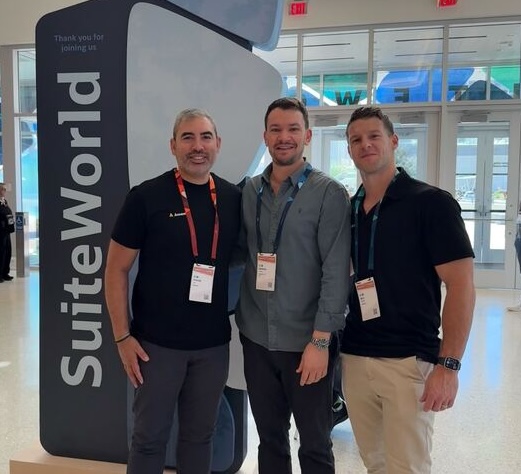SuiteWorld 2025 has wrapped for another year, and what a week it was. Over 12,000 delegates – including three from Annexa – joined in person and online to see and hear all that‘s new with Oracle NetSuite. Between the light shows, drone displays and a crowd-pleasing performance by Pitbull, what we learned is that NetSuite is about to make its biggest platform evolution in years – and of course that meant plenty of AI.
At the centre of it all was NetSuite Next. Oracle NetSuite founder and executive vice president, Evan Goldberg, went to far as to suggest NetSuite Next is nothing less than the future of NetSuite and the most significant update in the product’s 27-year history,
We’ve been sharing day by day recaps over on ITBrief:
- SuiteWorld 2025 Day 1 & 2 – NetSuite Next sets a new pace for AI in business
- SuiteWorld 2025 Day 3 recap: New AI-first products shaping NetSuite’s future
- SuiteWorld 2025 unpacked: highlights, implications and what it means for NetSuite users
Or, below we break down the key announcements as we share what it is, why it matters and when it’s coming.
NetSuite Next right inside your current suite
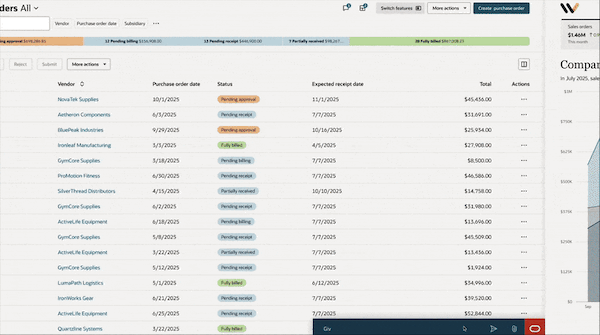
NetSuite Next is the next generation of NetSuite. It embeds conversational AI and agentic workflows across the suite to transform how AI works for business.
What: NetSuite Next is a mode customers can switch on, instantly transforming the suite they already use into an AI-powered environment. Built on Oracle Cloud Infrastructure, it adds intelligence and reasoning throughout the platform while keeping the same secure data, permissions and configurations. Once enabled, users gain access to a conversational interface, agentic workflows, an autonomous close process and a completely modernised Redwood user experience.
Why: NetSuite Next is designed to help teams move from searching for data to simply asking questions, from pushing reports to receiving insights and from manually executing processes to letting AI propose or perform them under clear guardrails. In simpler terms, NetSuite is starting to shift from systems of record to systems of reasoning.
When: Previews begin in North America within 12 months, with ANZ expected to follow in the second rollout wave around late 2026–27.
Ask Oracle for conversational insight and contextual action
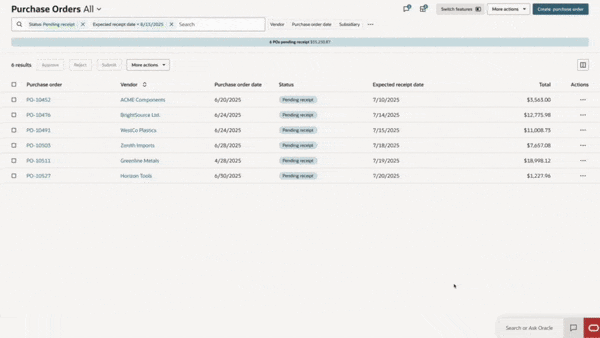
Core to the NetSuite Next user experience is Ask Oracle, a natural language assistant that enables users to search, navigate, analyze, and act across the entire NetSuite dataset using their own words.
What: The first glimpse of this shift is Ask Oracle, the new conversational assistant embedded soon to be embedded inside the suite. Users will be able to type or speak questions in plain language such as “Why did margins fall in Q3?” or “Show invoices waiting for approval,” and NetSuite will instantly respond with visual dashboards, narrative explanations and the reasoning behind each result.
Why: Ask Oracle adapts to the user’s role and context. A CFO might see profitability trends, while a warehouse manager would see fulfilment bottlenecks. It can also take action – for example, initiating approvals or updating records. This makes it less of a search bar and more of a business collaborator. For mid-sized ANZ organisations still spending hours in spreadsheets or custom reports, this could be transformative.
When: It ships as part of NetSuite Next. ANZ availability follows the region’s rollout schedule that is to be confirmed.
Agentic Workflows take you from manual steps to autonomous flow
What: Another centrepiece of NetSuite Next is Agentic Workflows – AI-driven processes that can suggest, build or execute complex tasks automatically. Examples include generating payment proposals, reconciling accounts or managing vendor selections. Users stay in control. They can review, edit or approve the AI’s recommendations, or allow the system to complete tasks autonomously within existing policy boundaries. The result is a workflow that runs continuously in the background, learning and improving over time.
Why: Agentic Workflows remove the repetitive, multi-step admin that slows down growth. Instead of chasing approvals or reconciling by hand, teams set the intent and let NetSuite do the heavy lifting – safely, visibly and within policy. For finance and operations teams, this could remove hours of repetitive work each week while further improving accuracy and compliance.
When: Agentic features are expected to roll out gradually with NetSuite Next. The first use cases will focus on financial operations (e.g. payments); further domains will follow.
Intelligent Payment Automation for finance that runs itself
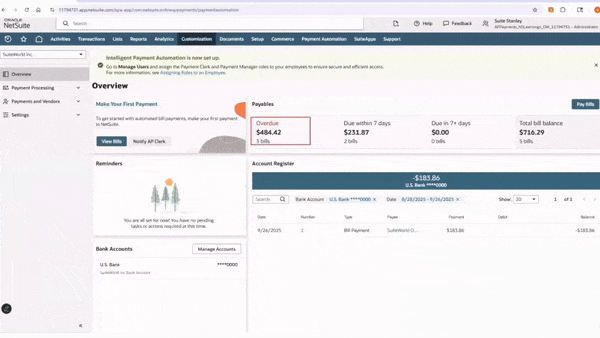
With NetSuite Intelligent Payment Automation, customers can capture and pay bills, track payment information, and plan batch payment runs from one central location.
What: Built in partnership with BILL, Intelligent Payment Automation brings end-to-end accounts payable inside NetSuite. It reads invoices, matches them to purchase orders, proposes payments based on cash-flow goals and executes them directly through BILL’s network of over eight million vendors. Reconciliation happens automatically within NetSuite, so finance teams no longer need to juggle between systems or import statements.
Why: This is the closest NetSuite has come to a fully self-driving finance process. By combining AI matching, cash-flow reasoning and direct payment execution, it eliminates data handoffs and human bottlenecks. For ANZ finance teams struggling with disconnected AP tools, this could potentially deliver true in-suite control of spend, cash and compliance.
When: The feature is already live in the United States and was one of the most discussed additions at SuiteWorld. ANZ customers can expect it later, once local banking and compliance frameworks are ready. When it lands, it will finally deliver the single-source-of-truth automation many finance teams have been chasing.
AI Canvas for planning, modelling and execution in one view
What: SuiteWorld also introduced AI Canvas, a new collaborative workspace inside NetSuite. Instead of exporting data to Excel or PowerPoint, teams can use AI Canvas to model “what-if” scenarios in real time – adjusting inputs, forecasting results and instantly triggering workflows when decisions are made. For example, a CFO might model a change in supplier costs, view the projected margin impact, and approve a pricing adjustment all within the same workspace. It’s planning, analysis and execution combined in one interactive view.
Why: AI Canvas collapses the gap between analysis and action. It brings finance, operations and sales together around the same live data, turning planning into a continuous process rather than a quarterly event. For ANZ businesses that run multi-department planning in silos, it offers a faster way to align and execute decisions directly in the ERP.
When: It becomes available once your instance is upgraded to NetSuite Next — timing aligned with the region’s rollout.
Autonomous Close is continuous accounting made real
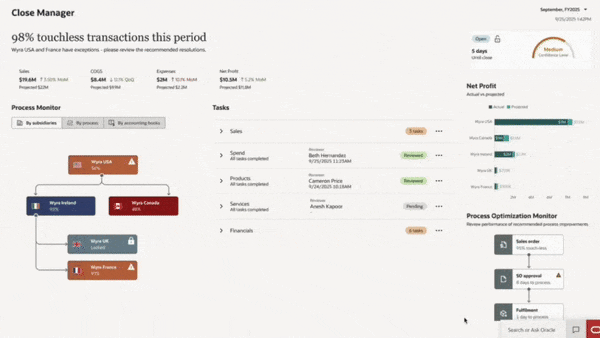
NetSuite Autonomous Close uses AI to automate and accelerate the financial close process, with the goal of achieving a “zero-day close”.
What: Few announcements drew as much attention from finance leaders as Autonomous Close. It promises to automate much of the month-end process by continuously monitoring transactions, detecting anomalies, reconciling entries, and tracking overall progress in a new Close Manager interface. Controllers will see exactly which tasks are complete, which are automated and where human review is needed. Oracle’s internal testing showed up to 98% of transactions handled automatically – a statistic that, if replicated in production, could redefine how month-end works.
Why: The month-end scramble has always been a pain point. Autonomous Close shifts that work forward – spotting issues early, posting transactions automatically and keeping finance leaders informed through the cycle. It reduces risk, accelerates close time and gives the CFO’s office real-time visibility across entities. For busy finance teams across Australia and New Zealand, this could be one of the most impactful advances of the entire SuiteWorld lineup.
When: Early previews already exist in the U.S. Global deployment follows in 2026–27, with ANZ expected to be included in that wave.
Subscription Metrics are SaaS-ready analytics out of the box
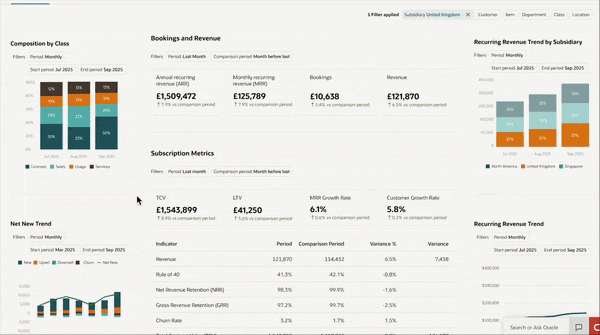
Subscription metrics helps track current results and future projections by showing key measures like MRR/ARR Growth, LTV and more
What: Another standout is Subscription Metrics, a pre-built SuiteApp tailored for SaaS and recurring-revenue businesses. It brings over 40 standard KPIs – including MRR, ARR, NRR, churn, CAC payback and LTV – into the core suite, along with cohort analysis, roll-forward reporting and AI-generated summaries that explain the “why” behind changes.
Why: Subscription businesses have long relied on fragile spreadsheets for recurring-revenue metrics. By baking these KPIs into the ERP, NetSuite gives CFOs a single source of truth for performance and growth. The coming AI narratives will add context automatically, turning dashboards into insight briefings for leadership teams and investors alike.
When: It’s available now globally at no additional cost, with narrative AI features expected within the next year.
SuiteAgents and the AI Connector opening NetSuite’s AI layer
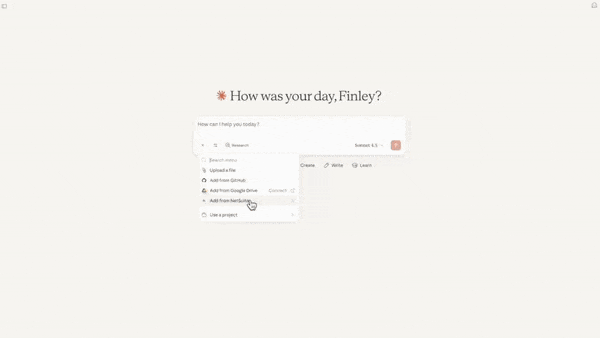
The NetSuite AI Connector Service is a protocol-driven integration service supporting Model Context Protocol (MCP) that gives customers a flexible and scalable way to connect their own AI to NetSuite.
What: For partners and advanced customers, the introduction of SuiteAgents and the AI Connector Service is big news. These tools allow the creation of custom AI agents that operate within NetSuite’s governance framework. Using the Model Context Protocol (MCP), external models can analyse NetSuite data safely and act according to existing roles and permissions. This means businesses can extend NetSuite’s intelligence to fit their industry logic – from credit approvals to service dispatch – while maintaining security and compliance. It also allows partners to build, deploy and tune AI agents directly within the SuiteCloud platform.
You can watch a longer video demo of the NetSuite AI Connector Service here.
Why: This securely opens NetSuite’s AI engine to innovation. Businesses and partners can design industry-specific agents that extend NetSuite’s reasoning without compromising data governance. For ANZ companies in niche sectors, it means the intelligence of NetSuite can finally match their operational complexity.
When: The Connector and preliminary tools are rolling out now. Full SuiteAgents access expands through 2025–26 and is tied to NetSuite Next availability.
SuiteCloud and developer enhancements
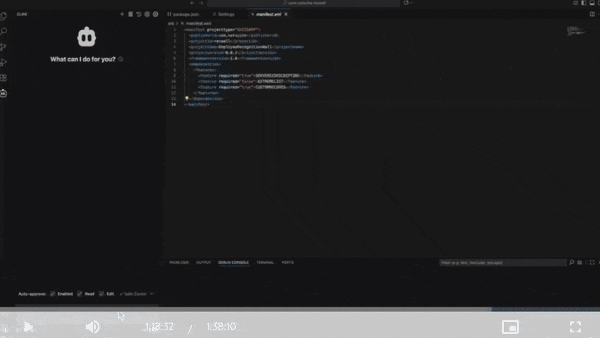
New open and composable capabilities in SuiteCloud bring AI directly into how businesses customise and extend NetSuite.
What: Oracle has also modernised the SuiteCloud platform itself. Developers gain TypeScript and SuiteScript 2.1 support, a new Developer Assistant that can generate code and documentation from natural language and updated toolkits for AI integration.
Why: These upgrades make it faster and safer to create new SuiteApps and localised extensions – something that will benefit ANZ’s vibrant NetSuite partner community in particular.
When: These upgrades are releasing now through early 2026, often incrementally by module or region.
The Redwood UI is modern, accessible, and yes, dark mode!
Did someone say DARK MODE? That’s right, dark mode is coming with NetSuite Next. #SuiteWorld pic.twitter.com/fOOhnU63ca
— NetSuite (@NetSuite) October 7, 2025
Among all the AI headlines, one announcement drew an unsurprising cheer – dark mode. It arrives as part of NetSuite’s Redwood UI, a clean, modern interface shared with Oracle’s wider cloud ecosystem. Beyond the aesthetic upgrade, Redwood brings improved accessibility, streamlined navigation and a more intuitive workspace.
Why: Redwood modernises the day-to-day experience. Faster navigation, fewer clicks and custom theming mean users spend less time fighting the system and more time using it. For businesses focused on adoption and productivity, this refresh matters as much as any AI feature.
When: Redwood updates have been rolling out for a while now but the full interface (including dark mode) is expected to become the standard with NetSuite Next.
Takeaways from SuiteWorld 2025
If you were looking for module enhancements and incremental feature updates, you might have left SuiteWorld 2025 a little disappointed. Because this year wasn’t about fine-tuning warehouse workflows or polishing order management screens. Instead of adding more menus or reports, NetSuite is doubling down on AI to turn the system into something that listens, learns and acts alongside its users.
There’s still work ahead. Many of these features won’t reach Australia and New Zealand until 2026 or later, but the direction feels right – more intuitive, more connected, and built for the way modern businesses actually work.
Upcoming Oracle NetSuite events in 2026
Oracle has confirmed SuiteWorld 2026 will return to Las Vegas on 26–29 October, and the SuiteConnect World Tour will reach Melbourne on 17 March and Sydney on 23 March 2026, giving ANZ customers an early look at what’s next.
